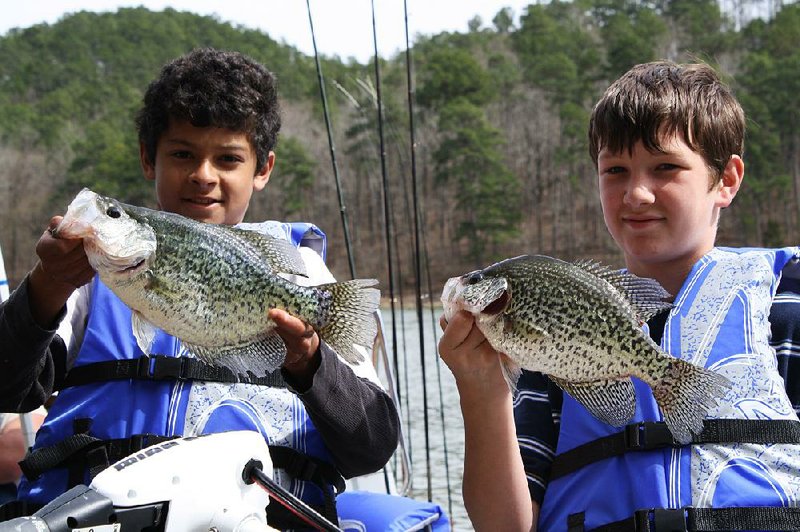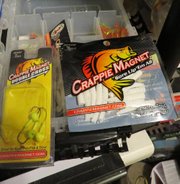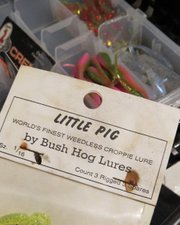Crappie fishing has peaked in Arkansas, but you can still catch good messes of post-spawn crappie with simple tactics.
Catching crappie in late spring and early summer can be hard unless you know where to look for fish. They abandoned the banks a long time ago, so you'll waste your time in shallow water haunts like laydowns and blowdowns. They're back in deep water hovering around brushpiles.
There's not a uniform standard for finding brushpiles that hold crappie. It varies by lake and depends on topography, water depth, water temperature and clarity. Crappie might hold to brushpiles in 12-15 feet at Lake Ouachita, but they might only be at 5-6 feet in a White River oxbow.
Crappie fishermen should also modify their expectations when fishing this time of year. It's always possible to catch a 30-fish limit, of course, but don't count on it. Fish are not as concentrated as they are in mid-spring, and they don't seem to eat as much or as aggressively. Consider 15-20 fish to be a good day.
On the other hand, you can also expect to catch big fish.
Last week I accompanied John Duncan and Grant Westmoreland on a crappie trip to DeGray Lake. Duncan is a guide and protege of Tammy Richardson, an accomplished crappie guide on DeGray who was a protege of Jerry Blake, a former guide at Lake Greeson who was one of the best crappie anglers to ever wet a line in this state.
Duncan runs a large number of brushpiles around DeGray, which fishes a bit differently than other lakes. I've fished it many times with different guides, and I have not known it to be a place that surrenders many fish from a single brushpile. You'll catch two or three from one pile, one or two from the next pile and so on. You don't think you're doing much until you look in the livewell and see that it's about full of fish. Big fish.
Duncan fishes differently than Richardson and Blake, too. Their method was to put out an array of poles rigged for different depths. Each pole had different colored tape that corresponded to the bobber color. They always used live minnows for bait.
They slowly trolled the baits over a brushtop, and when a bobber went down, they called out, "Blue down!" or "Red down!"
Blake described it as playing "Whack-a-mole," the arcade game, where heads pop up out of holes and you hit them with a mallet. If the fish were biting really well, it could be chaotic.
With Duncan, we only used a few rods. Instead of trolling over the tops, we drifted over them or fished stationary on tight lines.
Most of the tops we fished were in 14-20 feet of water. They were scattered in coves, secondary points and channel edges. We set our baits to run from about 9-12 feet. That's because crappie can be anywhere in a brushpile. If they are close to the bottom, they are nestled so tight into the cover that you can't get a bait to them. If they are suspended in the middle sections near the sides, they will hit minnows dangling over outer limbs.
It's best if they are suspended in the upper portions of a brushtop. Those are the fish that are most likely to rise to take a minnow over the top.
Those are also the fish that are most likely to hit an artificial bait. I am more suited to that style of fishing because it's faster paced. Bill Eldridge of Benton, an accomplished crappie angler at Lake Ouachita, taught me that technique, and Mark Hedrick of Little Rock showed me how to refine it.
A standard jig fishing setup includes a long, light-action spinning rig with 4- to 6-pound test line, light jigs from 1/16- to 1/64-ounce and a soft plastic lure of your choice. I like Bobby Garland Baby Shads in emerald shad color, but I also like Swimmin' R and a 21/2-inch Flea Fly Crappie Kicker. The Crappie Kicker is interesting because the body is only about 11/4-inch long with a long tail that exaggerates its action.
Eldridge likes twister tail jigs on standard lead jigs, but lately I am very impressed with Tiny Tom's weedless jigs. They are made in the Sebastian County hamlet of Huntington, and they are less prone to snagging in brushtops than jigs with unshielded hooks.
Properly positioning the boat is essential to fishing brush with jigs. I prefer to anchor a few yards downwind of a brushpile and cast upwind above the brushpile. A jig's fall rate depends on its weight, so you need to know how long it takes jigs of all weights to fall 1 foot.
Keep the bail of your reel open so that the jig falls straight down. Count it down a foot at a time so that when you begin reeling, it will nick the top of the brush as it comes across. Reel very slowly.
Hedrick uses shad color swimbaits. He uses a red Zoom marker to paint a thin stripe down the sides and rubs the stain into the bait with a finger. Unfortunately, Zoom does not make this product anymore, and when Hedrick finds them, he buys the entire inventory.
I experiment with various markers and scented dips, but I also like to spray my jig/tube combos with Gulp shad or crawdad scent. I can't say that there's a magic combination, but scent does seem to provoke more strikes.
The most important thing is to approach it with the right attitude. Enjoy yourself and take in the beautiful palette of color that we call Arkansas. If the fish bite, so much the better.
Sports on 06/05/2016


